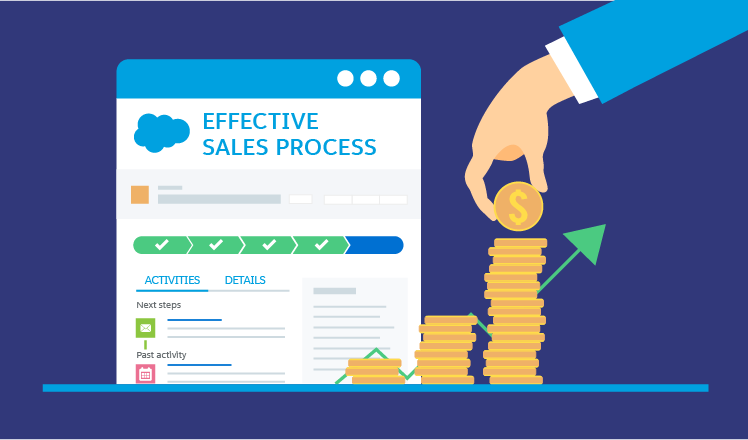How to streamline your sales process with Salesforce?
- 1 Introduction to Salesforce:
- 2 Why Salesforce Enhances the Sales Process:
- 3 How to Streamline Your Sales Process with Salesforce:
- 3.1 1. Define Your Sales Process:
- 3.2 2. Configure Your Salesforce Instance:
- 3.3 3. Manage Your Leads:
- 3.4 4. Manage Your Opportunities:
- 3.5 5. Automate Your Sales Process:
- 3.6 6. Analyze Your Sales Performance:
- 3.7 7. Collaborate with Your Sales Team:
- 4 Conclusion:
Salesforce is a leading customer relationship management (CRM) software that helps businesses of all sizes streamline their sales processes. By using Salesforce classes, companies can leverage the power of this platform to automate their sales processes, improve collaboration among sales teams, and increase sales productivity.
This article will discuss how businesses can streamline their sales process with Salesforce and why it is essential for success.
Introduction to Salesforce:
Salesforce is a cloud-based CRM platform that provides businesses with various tools and functionalities to manage their customer relationships effectively. With Salesforce, companies can automate their sales processes, manage customer data, and analyze sales performance, according to the industry experts of the Salesforce classes.
Salesforce is an intuitive and user-friendly platform that is easy to use, even for non-technical users. The platform is highly customizable and can be tailored to meet the unique needs of businesses of all sizes. Salesforce also offers a range of integrations with third-party applications, making it easy for companies to connect their sales processes with other business processes.

Why Salesforce Enhances the Sales Process:
Salesforce enhances sales by providing businesses with various tools and functionalities to manage their sales activities effectively. With Salesforce, companies can automate their sales processes, allowing them to focus on high-value activities that drive sales growth. The platform also provides sales teams access to real-time data, enabling them to make informed decisions that drive sales performance.
Salesforce also enhances collaboration among sales teams, allowing them to work together seamlessly to close more deals. The platform provides the sales team access to a shared customer information database, making coordinating their efforts easy and avoiding duplicating work. Salesforce also provides sales teams with communication tools, allowing them to communicate quickly with each other and customers.
How to Streamline Your Sales Process with Salesforce:
1. Define Your Sales Process:
The first step in streamlining your sales process with Salesforce is to define it. A well-defined sales process is critical to the success of any sales team, as it provides a clear roadmap for approaching and closing deals. Your sales process should be based on your business goals and customer needs.
To define your sales process, you should identify the critical stages of your sales cycle, including lead generation, lead qualification, opportunity management, and closing deals. It would help if you also defined the key activities at each sales cycle stage and the metrics you will use to measure your success.
2. Configure Your Salesforce Instance:
Once you have defined your sales process, the next step is to configure your Salesforce instance to support your sales activities. Salesforce is highly customizable, allowing you to tailor the platform to meet the unique needs of your business.
To configure your Salesforce instance, create custom fields, objects, and workflows that align with your sales process. You should also set up automation rules, such as lead assignment and lead scoring rules, to streamline your sales activities and improve the accuracy of your data, advising the mentors of the Salesforce classes.
3. Manage Your Leads:
Lead management is a critical aspect of any sales process, and Salesforce provides businesses with a range of tools to manage their leads effectively. With Salesforce, companies can capture leads from various sources, including web forms, social media, and email campaigns.
Once you have captured your leads in Salesforce, you should use lead scoring to prioritize them based on their engagement level and the likelihood of conversion. It would help if you also used lead assignment rules to assign leads to the most appropriate sales reps based on location, expertise, and workload.
4. Manage Your Opportunities:
Opportunity management is the process of managing and tracking the progress of deals through the sales pipeline. Salesforce provides businesses with a range of tools to manage their opportunities.
Once you have qualified your leads, you should convert them into opportunities in Salesforce. Opportunities represent potential deals that your sales team is working on, and they provide a central location for tracking the progress of each deal.
With Salesforce, you can track the key details of each opportunity, including the deal size, expected close date, and the stage of the sales process. You can also track the activities that have taken place for each opportunity, such as calls, emails, and meetings.
5. Automate Your Sales Process:
Salesforce provides businesses with a range of automation tools that can help streamline their sales process. By automating repetitive tasks, you can free up your sales team to focus on high-value activities that drive sales growth.
One of Salesforce’s most powerful automation tools is workflow automation. With workflows, you can automate various activities, such as sending follow-up emails, updating records, and assigning tasks to sales reps. You can also use Salesforce’s process builder to create complex workflows that involve multiple steps and conditions.
6. Analyze Your Sales Performance:
Analyzing sales performance is critical to improving sales processes and driving sales growth. According to the Salesforce classes, businesses can access real-time data on their sales performance, enabling them to make informed decisions about their sales strategy.
Salesforce provides businesses with various analytics tools, including dashboards, reports, and forecasting. With these tools, you can track key performance metrics, such as lead conversion rates, pipeline velocity, and win rates. You can also use forecasting tools to predict your sales revenue based on your pipeline.
7. Collaborate with Your Sales Team:
Collaboration is critical to the success of any sales team, and Salesforce provides businesses with a range of collaboration tools to help their sales teams work together more effectively. With Salesforce, sales teams can communicate with each other and customers using various tools, including chat, email, and social media.
Salesforce also provides businesses various collaboration features, such as shared calendars, task management, and file sharing. By collaborating effectively, sales teams can close more deals and drive sales growth.
Conclusion:
Streamlining your sales process with Salesforce can help your business improve sales productivity, increase collaboration among your sales teams, and drive sales growth. By defining your sales process, configuring your Salesforce instance, managing your leads and opportunities, automating your sales process, analyzing your sales performance, and collaborating with your sales team, you can leverage the power of Salesforce to optimize your sales activities and improve your bottom line.
With Salesforce classes, businesses can learn how to use Salesforce effectively and unlock the full potential of this powerful platform.
The above content credit goes to cloudintellect.in

















